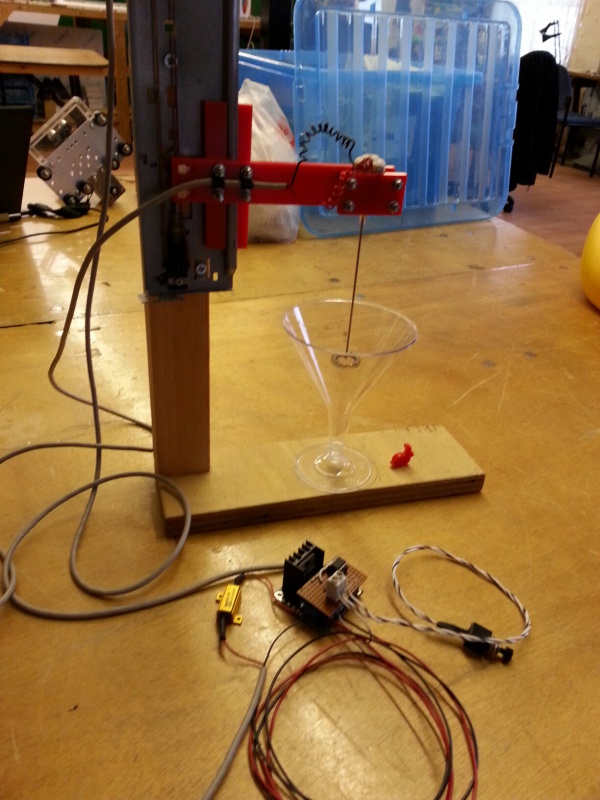BarBot/Components/Stirrer: Difference between revisions
Iandickinson (talk | contribs) No edit summary |
Iandickinson (talk | contribs) |
||
| Line 4: | Line 4: | ||
Sorry Mr Bond, our BarBot cannot do a shaken Dry Martini! | Sorry Mr Bond, our BarBot cannot do a shaken Dry Martini! | ||
The BarBot stirrer consists of a "swizzler" attached to a recycled printer carriage mechanism. The carriage and swizzler motors are controlled by a ATtiny85 and L298N dual H-bridge. There is a 10R 15W resistor in series with the swizzler motor, to reduce the voltage. The cycle is started by applying a LOW pulse /TRIG input of the ATtiny85. It then lowers, swizzles, then raises to the top ready for next time. | The BarBot stirrer consists of a "swizzler" attached to a recycled printer carriage mechanism. The carriage and swizzler motors are controlled by a ATtiny85 and L298N dual H-bridge. There is a 10R 15W resistor in series with the swizzler motor, to reduce the voltage. The cycle is started by applying a LOW pulse on the /TRIG input of the ATtiny85. It then lowers, swizzles, then raises to the top ready for next time. | ||
[[File:20140627 160043 resized.jpg|none|600px|BarBot Stirrer]] | [[File:20140627 160043 resized.jpg|none|600px|BarBot Stirrer]] | ||
Revision as of 14:55, 9 August 2014
Stirrer
General Description
Sorry Mr Bond, our BarBot cannot do a shaken Dry Martini!
The BarBot stirrer consists of a "swizzler" attached to a recycled printer carriage mechanism. The carriage and swizzler motors are controlled by a ATtiny85 and L298N dual H-bridge. There is a 10R 15W resistor in series with the swizzler motor, to reduce the voltage. The cycle is started by applying a LOW pulse on the /TRIG input of the ATtiny85. It then lowers, swizzles, then raises to the top ready for next time.

Notes:
- Watch out for the shake!
Mounting & hardware
The printer carriage mechanism has a few holes that can be used for mounting. It needs to be positioned such that the swizzler is in the liquid when it is at it's lowest point.
Logical
To start the cycle the /TRIG line of the ATtiny85 needs to be pulsed low for at least 5 msec. One cycle takes approx 12.5 seconds to complete.
Connections
- +12V
- Ground
- /TRIG ("start" signal)
Power
+12V, TBC mA
Bling
None really! However, there is a red LED on the L298N module which illuminates when power is available.